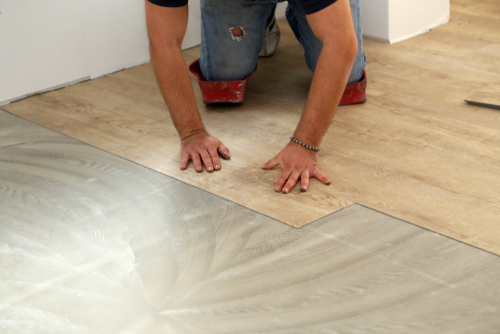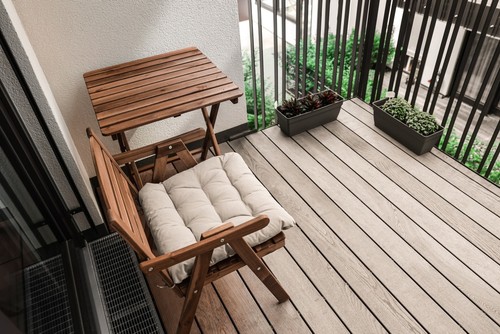
Maintaining Bamboo Floors: Best Practices
November 27, 2023
Eco-Friendliness of Vinyl Plank Flooring
February 28, 2024
Outdoor Flooring Options for Patios and Balconies. The selection of outdoor flooring for patios and balconies is a critical decision that impacts the aesthetics, functionality, and durability of these outdoor living spaces.
In urban environments, particularly, where patios and balconies serve as vital extensions of the indoor living area, choosing the right flooring material can transform these spaces into inviting, functional, and stylish retreats.
This comprehensive guide aims to navigate through the multitude of outdoor flooring options available, assisting in making an informed choice that aligns with personal style, practical requirements, and environmental conditions.
When it comes to outdoor flooring, there is a diverse range of materials to consider.
Each comes with its unique set of characteristics, pros, and cons. The most popular choices include tile, wood, concrete, composite, and artificial grass, each offering different benefits in terms of durability, maintenance, aesthetics, and installation.
Table of Contents
The Need for Durable Outdoor Flooring
Outdoor flooring must withstand varying weather conditions, wear and tear from foot traffic, and other outdoor elements while maintaining its visual appeal.
Therefore, the choice of flooring material is not just about aesthetics but also about its resilience, maintenance needs, and suitability to the local climate.
The right flooring can enhance the value of the property, improve the usability of outdoor spaces, and reflect the homeowner’s style.
Types of Outdoor Flooring
Tile Flooring

Tiles are a popular choice for outdoor spaces due to their durability and aesthetic versatility. Available in various materials, including ceramic, porcelain, and stone, tiles can withstand harsh weather conditions and heavy foot traffic. They come in a wide range of designs, colors, and textures, allowing for customization to fit any design theme.
Ceramic and Porcelain Tiles
Ceramic and porcelain tiles are favored for their ability to mimic the look of natural stone, wood, or concrete at a more affordable price point. Porcelain tiles, in particular, are known for their strength, water resistance, and low maintenance requirements.
Stone Tiles
Natural stone tiles, such as slate, granite, or travertine, offer a unique and elegant look. Each piece is distinct, adding a natural charm to outdoor spaces. However, they require more maintenance than ceramic or porcelain and can be more expensive.
Wooden Decking
Wooden decking adds warmth and natural beauty to outdoor spaces. It’s a versatile option that complements a range of architectural styles, from traditional to modern.
Common choices for wooden decking include pressure-treated lumber, cedar, redwood, and exotic hardwoods like ipe and teak. Each type of wood has its unique grain, color, and durability characteristics. Hardwoods, while more expensive, offer greater longevity and a rich, sophisticated look.
Wooden decking requires regular maintenance to preserve its appearance and longevity. This includes periodic cleaning, staining, or sealing to protect against moisture, UV rays, and potential insect damage.
Concrete Flooring
Concrete is an increasingly popular choice for outdoor flooring due to its durability and modern aesthetic appeal.
It can withstand extreme weather conditions and heavy use, making it ideal for high-traffic outdoor areas.
Concrete flooring offers a range of design options, including stamped patterns, staining, and texturing.
These techniques can mimic the look of natural stone, brick, or even wood, providing versatility in design while maintaining the strength and durability of concrete.
Concrete is relatively low-maintenance, requiring only occasional cleaning and resealing to maintain its appearance. It’s a long-lasting option that can endure for decades with proper care.
Composite Decking

Composite decking, made from a mixture of wood fibers and recycled plastics, is a sustainable and low-maintenance alternative to traditional wood decking.
It combines the aesthetic appeal of wood with the durability and ease of maintenance of synthetic materials.
Advantages Over Traditional Materials
Composite decking is resistant to rot, decay, and insect damage. It doesn’t require the regular maintenance of wooden decking, such as staining or sealing, and is available in a variety of colors and finishes.
Its composition makes it less susceptible to weather-related damage and fading.
Innovative Design Possibilities
Composite decking can be used in creative ways, incorporating different colors and patterns to create unique outdoor spaces.
It’s suitable for a variety of design styles, from classic to contemporary, providing the look of natural wood without the associated upkeep.
Artificial Grass

Artificial grass is an excellent option for those looking to add a touch of greenery to their outdoor space without the maintenance of natural grass.
It’s ideal for areas where growing real grass is challenging due to shade or poor soil conditions.
Benefits of Artificial Grass
Artificial grass requires minimal maintenance, with no need for watering, mowing, or fertilizing. It provides a consistently green and manicured appearance year-round and is particularly suitable for pet owners, as it’s easy to clean and resistant to wear from pets.
Integrating with Other Flooring Options
Artificial grass can be combined with other flooring materials like pavers, tiles, or decking to create a dynamic and multi-textured outdoor space.
This combination can define different areas within a patio or balcony, such as a dining area, lounge space, or play area.
Factors to Consider When Choosing Outdoor Flooring

When selecting outdoor flooring, several factors need to be considered to ensure the chosen material meets your needs and preferences.
Weather Resilience and Material Durability
The chosen flooring should be able to withstand the specific climate conditions of your area. Materials that are resistant to moisture, UV radiation, and temperature fluctuations are ideal for outdoor use.
Maintenance Requirements
Consider the level of maintenance you are willing to commit to. Some materials, like natural wood, require more upkeep to maintain their appearance, while others, like composite decking or tiles, are more low-maintenance options.
Aesthetic Appeal and Design Flexibility
The flooring should complement the architectural style of your home and fit your personal design preferences. Consider the overall look you want to achieve and how the flooring will integrate with existing outdoor elements.
Safety and Comfort
Safety is a crucial aspect, especially in spaces used frequently. Look for materials that provide good traction and are comfortable to walk on. This is particularly important in areas that are often wet or used by children and the elderly.
Installation Process and Ease
Some flooring options may require professional installation, while others are suitable for DIY projects. Consider the installation process and whether you have the skills and tools required for a successful installation.
Outdoor Flooring Options for Patios and Balconies – Conclusion

Choosing the right flooring for patios and balconies is essential to creating functional, stylish, and comfortable outdoor living spaces.
By considering factors such as durability, aesthetics, maintenance, and safety, you can select a flooring option that enhances the beauty of your outdoor area and suits your lifestyle.
Whether you prefer the natural beauty of wood, the modern appeal of concrete, the low maintenance of composite, or the green look of artificial grass, there is a flooring option to meet every need and preference.
With the right choice, you can transform your outdoor space into a beautiful and inviting extension of your home.
Are you looking for a professional and reliable flooring installation or supplier in Singapore? Contact us today!



